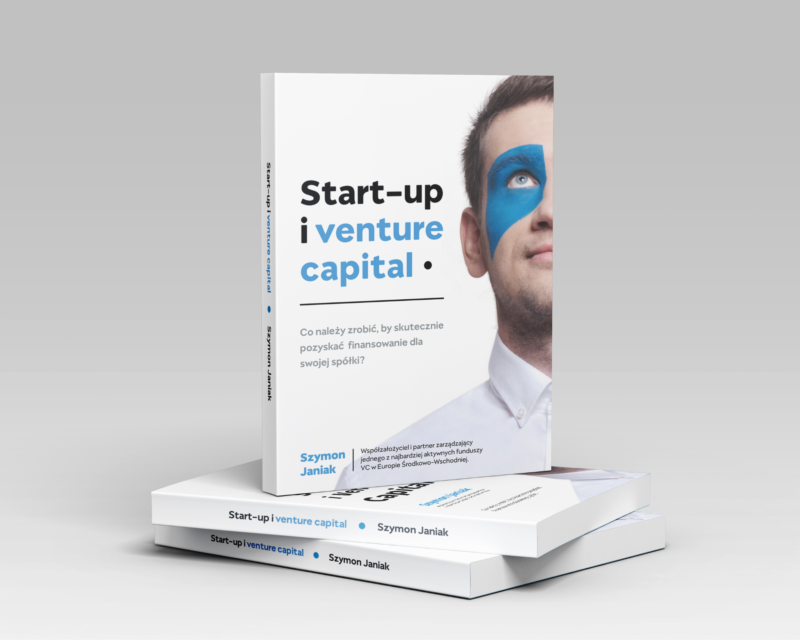Od wielu lat aktywnie działa Pan na rynku venture capital, na którym wielu młodych startupowców upatruje szansy na rozwój swoich firm. Czy to z myślą o nich powstała Pana książka?
– Pomysł na tę książkę zrodził się z moich personalnych doświadczeń. Kiedyś, gdy byłem po drugiej stronie, będąc startupowcem, przymierzałem się do pozyskiwania kapitału i miałem z tym ogromny problem. Nie było wtedy żadnego źródła wiedzy, z którego mógłbym się w kompleksowy i pragmatyczny sposób dowiedzieć, co powinienem właściwie robić. Działałem więc metodą prób i błędów. Nawet tworząc prezentację dla inwestora, przygotowałem aż 80 stron i wydawało mi się, że tego się nie da skrócić.
Tymczasem to było nie do przejścia dla normalnego inwestora. Również siadając do rozmów, skupiałem się na budowaniu wielkich wizji, tworzeniu projekcji, jak powinna wyglądać przyszłość, zamiast przedstawić to, co jest interesujące dla inwestorów, czyli jak zamierzamy tworzyć wartość spółki i zarabiać.
Wiele lat później, stojąc już po drugiej stronie barykady, doszedłem do wniosku, że nic się nie zmieniło i wciąż nie ma gdzie zdobyć tej wiedzy. Pojawiają się pojedyncze, tematyczne artykuły na Linkedinie, czasem podcasty. Zdarzały się też oczywiście publikacje na temat venture capital i startupów, ale one były osadzone w realiach rynku amerykańskiego. Tymczasem Dolina Krzemowa, póki co z Wrocławiem czy Warszawą ma jeszcze niewiele wspólnego. Dlatego uznałem, że czas dać founderom trochę więcej wiedzy i podzielić się tym, co z naszej, inwestorskiej perspektywy jest ważne. Jestem przekonany, że ostatecznie zadziała to pozytywnie dla obu stron – zarówno dla funduszy, jak i samych startupów.
Wiedza niezbędna dla startupowców
Jaką wiedzę dzięki Pana książce mogą zdobyć startupowcy?
– Książka ma dwa główne przekazy. Pierwszym z nich jest zestaw pragmatycznych wskazówek, co dany człowiek powinien zrobić, aby pozyskać kapitał na inwestycje, czyli m.in. jak przygotować do tego swoją spółkę, żeby w ogóle zacząć o tym myśleć. Czy venture capital jest rozwiązaniem dla niego? Jeśli tak, to w jaki sposób podejść do inwestora i jak z nim rozmawiać, żeby to wszystko się udało.
Natomiast drugi przekaz to moje autorskie spojrzenie na polski rynek venture capital – nieco z przymrużeniem oka i z pewnym dystansem. Jest on bowiem dość specyficzny i hermetyczny. Z jednej strony brakuje tu otwartej krytyki patologicznych praktyk, a z drugiej pewnej otwartości. Inwestycje venture capital mają charakter partnerski, gdzie pomiędzy inwestorem a startupem musi być tzw. „match”. Obie strony powinny nadawać na podobnych falach i muszą się rozumieć. Tylko wówczas możemy mówić o szansach na udaną współpracę w przyszłości.
Zatem w swojej książce raczej dodaje Pan skrzydeł founderom i popycha ich do szybszego działania, czy raczej ściąga ich Pan na ziemię?
– Zdecydowanie to drugie. Jestem realistą i podchodzę do świata, analizując go przez pryzmat danych czy faktów. Dlatego raczej staram się przekazywać dużo pragmatycznej wiedzy, żeby przygotować founderów na to, co może ich spotkać. Prawda jest taka, że fundusz, który wchodzi w daną spółkę też ma pewne wymagania. Niekoniecznie są one związane stricte z finansami. Chodzi też o stworzenie technologii czy rozpoczęcie operacji na kilku rynkach. Wtedy współpracujemy z founderem, tworzymy wspólny plan i chcemy pomóc mu w tym, żeby rósł w szybszym tempie, niż odbywałoby się to bez zewnętrznego kapitału.
Taki też jest cel – pomóc w szybszym rozwoju spółki, która już wie, w którą stronę chce zmierzać. Warto jednak pamiętać, że dobre fundusze inwestują jedynie w około 1 proc. startupów, które się do nich zgłaszają. Dlatego warto się do tego dobrze przygotować – poczytać na ten temat, zrozumieć tę drugą stronę, porozmawiać z founderami, którzy mają już taką współpracę za sobą.
To pozwoli też odczarować wiele mitów na temat branży venture capital, m.in. że przejmiemy władzę nad spółką, będziemy im mówić, co mają robić czy zrobimy z nich pracowników. To ma niewiele wspólnego z rzeczywistością. Dobry fundusz to taki, który popycha foundera dokładnie w tę stronę, w którą on chciałby iść. Daje mu jedynie możliwość szybszego rozwoju, nie ingerując w to, co robi na co dzień.
Przydatne informacje o tym, jak pozyskiwać kapitał
Książka jest przeznaczona przede wszystkim dla founderów. Czy ktoś jeszcze znajdzie tam coś dla siebie?
– Z pewnością każdy, kto interesuje się branżą venture capital. W tym środowisku bardzo istotną rolę pełnią prawnicy transakcyjni, akceleratory, które biorą udział w procesie inwestycyjnym, a także dziennikarze, wspierający scenę technologiczną. Zatem de facto każdy, kto chciałby się dowiedzieć, jak działa venture capital i jak pozyskuje się kapitał, powinien znaleźć tu odpowiedzi.

“Start-up i venture capital” Szymon Janiak
Ma Pan duże doświadczenie, jeśli chodzi o venture capital…
– Od ponad dziesięciu lat działam na polskiej scenie technologicznej i to w różnych aspektach. Zaczynałem od marketingu i business developmentu projektów technologicznych. Później zajmowałem się doradztwem przy wycenach startupów w ramach restrukturyzacji, fuzji i przejęć, czyli twardej inżynierii finansowej.
Następnie tworzyliśmy własne startupy. To była jedna z najciekawszych przygód w moim życiu, jeśli chodzi o budowane czegoś tak szybko i w tak ryzykownym i krótkim tempie. Wówczas funkcjonowaliśmy na trzech kontynentach – we Wrocławiu mieliśmy centrum zarządzania, w Azji produkcję, a w Dolinie Krzemowej sprzedaż i marketing. Było to bardzo ciekawe doświadczenie, które pokazało mi, jak biznes wygląda od strony foundera.
Kolejnym krokiem był już własny fundusz, który razem ze wspólnikiem budowaliśmy od podstaw. Wówczas w Polsce był „Dziki Zachód” i wszystko się dopiero tworzyło – nie było lokalnych standardów ani praktyk. To było trochę naśladowanie tego, co działo się na rynku amerykańskim i próba implementacji podobnych działań w Polsce. Wówczas działało u nas około trzydziestu takich funduszy. Dziś jest ich ponad 130.
Przeszliśmy długą drogę, ale teraz jesteśmy już o wiele dalej w tym zakresie. Nasz rodzimy rynek staje się coraz bardziej dojrzały. Jest wiele ciekawych spółek, ale też funduszy, z którymi warto wejść we współpracę. Jako Czysta3.vc inwestujemy na tzw. etapie zalążkowym, gdy spółki dopiero tworzą swoje przedsięwzięcia. Aktualnie nasz portfel generuje kilkadziesiąt milionów przychodów rocznie.
W venture capital kluczowa jest własność intelektualna
Czy venture capital dotyczy tylko spółek technologicznych?
– Generalnie tak, gdyż w venture capital kluczowa jest własność intelektualna. Z perspektywy oceny danej spółki w pierwszej kolejności zwraca się uwagę na takie wartości, jak zespół, parametry finansowe czy model biznesowy. Jednak na końcu zawsze jest ta unikalna własność intelektualna, która jest zapisana w postaci kodu, umożliwiającego realizację usług lub stworzenie innowacyjnego produktu. Musi to być coś namacalnego – wyjątkowego, co sprawia, że można to skalować i ten sam model biznesowy implementować na innych rynkach.
Jakie były najciekawsze przedsięwzięcia, w które Pan zainwestował?
– Ciężko wybrać i wskazać jednoznacznie, ponieważ nasze portfolio inwestycyjne jest zróżnicowane. Inwestujemy w internet ventures, czyli spółki z różnych branż, których wspólnym mianownikiem jest internet, jako środowisko, w którym funkcjonują. Mogą to być rozwiązania z bardzo różnych branż. Na przykład w naszym portfolio znajduje się firma, która stworzyła algorytm sztucznej inteligencji, pozwalający ocenić, czy dana działka nadaje się na stworzenie farmy fotowoltaicznej.
Mamy też spółkę, która na bazie testów psychometrycznych pozwala oszacować, czy dany człowiek nadaje się na określone stanowiska pracy. Jedną z naszych ostatnich inwestycji jest przedsiębiorstwo, które na bazie zdjęć satelitarnych ocenia, jak kopalnia wpływa na krajobraz i otoczenie, w którym funkcjonuje.
Wszystkie te przedsięwzięcia są niezwykle ciekawe. To jest jedna z najfajniejszych rzeczy w tej branży, bo człowiek się nieustannie uczy i widzi, w jaki sposób technologia może nas wspierać w tym, co realizujemy. Pokazuje, że możemy zdigitalizować procesy, które do tej pory wydawały się takimi, które w swojej tradycyjnej formie będą funkcjonowały po wsze czasy. Dlatego też inwestujemy na tzw. etapie zalążkowym, gdy spółki są jeszcze w trakcie tworzenia swojego przedsięwzięcia.




